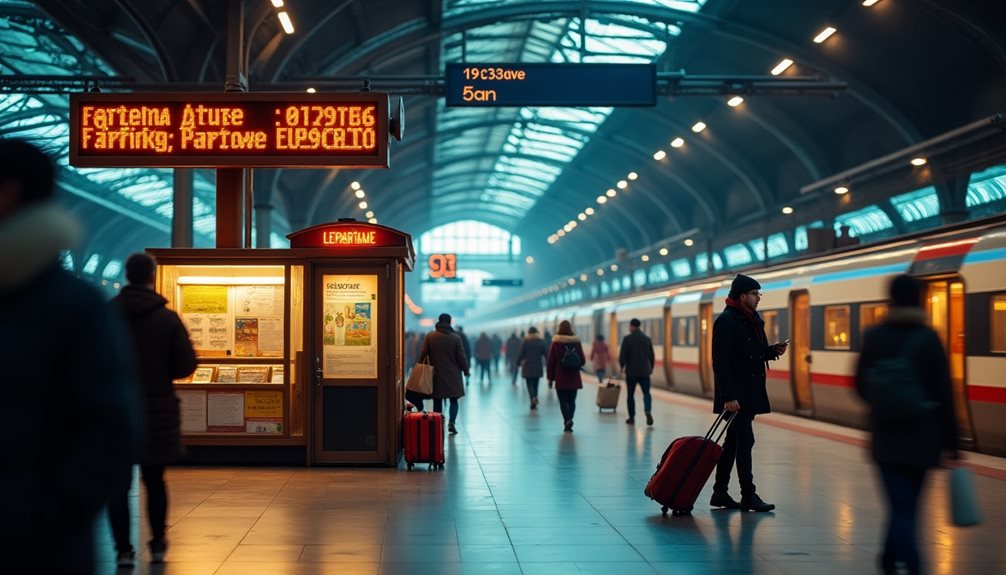Table of Contents
ToggleEssential Russian Phrases for Travelers

Travelers traversing Russia will benefit from mastering essential phrases that facilitate communication and enhance their experience. Understanding key expressions, such as “gde?” (where?), “skolko?” (how much?), and “pazhaluysta” (please), is vital for managing local interactions.
These essential phrases not only aid in acquiring services but also demonstrate respect for Russian culture, which is integral to travel etiquette. A simple greeting, like “Zdravstvuyte” (hello), can open doors to more meaningful exchanges.
Additionally, using polite expressions fosters goodwill among locals, enhancing the overall travel experience. By prioritizing these essential phrases, travelers empower themselves, creating opportunities for exploration and connection while respecting cultural norms and expectations.
Traveling in Russia offers a wonderful opportunity to experience the country’s vast landscapes, vibrant cities, and unique culture. Knowing some basic transportation vocabulary in Russian will make your journey much easier and more enjoyable. Whether you’re catching a train across Siberia or taking the metro in Moscow, these words and phrases will help you navigate Russian transportation with confidence.
Below are some key terms every traveler should know:
| Russian Word | English Translation | Pronunciation | Definition |
|---|---|---|---|
| билет | ticket | bee-LYET | A pass or document that allows you to use a train, bus, or other form of transport. |
| платформа | platform | plat-FOR-ma | The area where you board a train or subway. |
| вокзал | station (train/bus) | vak-ZAL | The main building where you find trains or buses. |
| поезд | train | PO-yezd | A series of rail cars that transport passengers. |
| метро | metro/subway | mye-TRO | The underground train system in cities like Moscow or St. Petersburg. |
| автобус | bus | av-TO-bus | A vehicle for city or long-distance travel by road. |
| маршрутка | minibus | mar-SHROOT-ka | A shared taxi or minibus, common in Russian cities. |
| остановка | stop (bus/train) | as-ta-NOV-ka | A place where buses, trams, or trains stop along the route. |
| расписание | schedule/timetable | ras-pee-SA-ni-ye | A list showing when transport departs and arrives. |
| отправление | departure | at-prav-LEN-i-ye | The time when a vehicle leaves. |
| прибытие | arrival | pree-BY-tee-ye | The time when a vehicle arrives at its destination. |
| касса | ticket office | KASS-a | The counter or booth where tickets are sold. |
Useful Phrases for Travelers
Here are some common Russian phrases that can help you in stations or when asking locals for help:
- Где находится станция метро?
(Gde nakhódit-sya stán-tsi-ya me-tró?)
Where is the metro station? - Сколько стоит билет до Москвы?
(Skól-ko stó-it bee-LYET do Mosk-VY?)
How much is a ticket to Moscow? - Когда следующий поезд?
(Kog-dá sled-u-yush-chee PO-yezd?)
When is the next train? - Это мой вагон?
(Eto moy va-GON?)
Is this my carriage/car?
Tips for Using Transportation in Russia
- Russian stations are well-organized but can be busy, especially in large cities.
- Most information is posted in Cyrillic, so being able to read basic words can be very helpful.
- Staff may not speak English, so practicing pronunciation can make communication smoother.
- Keep your ticket until the end of your trip—you may need it to exit stations.
- Marshrutkas (minibuses) are common and inexpensive; just tell the driver where you want to get off.
Understanding these terms not only helps you travel with ease but also shows respect and interest in Russian culture. It can open doors to friendly conversations and positive experiences with locals, making your journey more memorable.
Russia’s public transport system is extensive, reliable, and affordable. With just a little bit of Russian vocabulary, you’ll find it much easier to explore all the country has to offer—from historic cities to scenic countryside.
Navigating the Metro System
The Russian metro system is one of the most famous and efficient in the world, especially in cities like Moscow and Saint Petersburg. However, traversing it can initially seem intimidating for newcomers. Understanding metro etiquette is vital for a smooth experience; passengers should stand to the right on escalators, allowing others to pass on the left.
Ticket purchasing is another essential aspect; newcomers should familiarize themselves with various options, including single-ride tickets and multi-ride passes. Automated kiosks often provide English language options, easing the process. It is advisable to have small change or a bank card ready for transactions.
Additionally, observing local customs, such as yielding seats to the elderly, enhances the communal atmosphere. Overall, mastering these basic elements empowers travelers to navigate the metro confidently and independently.
Metro Etiquette
Understanding unwritten rules helps you blend in:
- Stand to the right on escalators; the left side is for people in a hurry.
- Let passengers exit before entering a train.
- Yield seats to the elderly, disabled, pregnant women, or passengers with children.
- Keep backpacks off your back in crowded trains to save space.
Buying Tickets
There are several ways to buy metro tickets:
- Single-ride tickets (разовый билет, [RAH-zuh-viy bee-LYET]) are best for occasional trips.
- Multi-ride passes (проездной, [pra-eez-NOY]) save money if you travel often.
- Automated kiosks (терминал, [teer-mee-NAHL]) often have an English option. You can also pay with a bank card or cash.
- Metro cards (карта метро, [KAR-ta mee-TROH]) are reusable and convenient for frequent travelers.
Useful Russian Metro Terms
Below is a table of common Russian metro words and phrases you might see or need when using the metro:
| Russian (Cyrillic) | Phonetic (English) | English Definition |
|---|---|---|
| метро | meh-TROH | metro/subway |
| вход | VKHOD | entrance |
| выход | VY-khad | exit |
| эскалатор | eh-ska-LA-tor | escalator |
| поезд | POY-ezd | train |
| станция | STAN-tsi-ya | station |
| билет | bee-LYET | ticket |
| касса | KAH-sa | ticket office/counter |
| терминал | teer-mee-NAHL | ticket machine/kiosk |
| карта | KAR-ta | card |
| линия | LEE-nee-ya | line (as in metro line) |
| переход | peh-ree-KHOD | transfer/interchange |
| следующая станция | SLYE-du-yu-sha stan-tsi-ya | next station |
| Осторожно, двери закрываются! | ah-sta-ROZH-nah, DVYEH-ree zah-kree-VA-yut-sya! | Caution, doors are closing! |
Tips for Metro Travel
- Always keep your ticket or card until you leave the metro system; you might need it to exit.
- Listen for station announcements, which are usually made in Russian. Some central stations also announce in English.
- Study a metro map (карта метро) before your trip and identify your starting and ending stations.
By learning these basics and practicing the Russian terms above, you’ll find it much easier—and more enjoyable—to use the metro in Russia.
Understanding Bus and Tram Terminology
Understanding how to use buses and trams in Russian cities is very useful for anyone traveling or living there. The Russian public transportation system is extensive, and knowing the right terms makes your journey much easier.
In Russian, a bus is called автобус (av-TOH-boos). Bus routes are referred to as маршруты автобусов (mar-SHROO-ty av-TOH-boos-ov). Each route has a number, for example, автобус номер 12 (av-TOH-boos NOH-mer dvad-tsat’), meaning “bus number 12.” These numbers are displayed on the front and side of the bus. It’s important to check the route number and its direction before boarding. Many large cities have maps at each bus stop, showing all the available routes.
Trams are another common form of transport and are called трамвай (tram-VAI). The plural is трамваи (tram-VAI-ee). Tram stops are known as остановки трамваев (ah-sta-NOF-kee tram-VAI-ev). The word остановка (ah-sta-NOF-ka) means “stop.” At each stop, you’ll often see a sign with a white А on a blue background for buses, or a tram symbol for trams, sometimes accompanied by the schedule (расписание – ras-pee-SA-nee-ye) and a list of stops (список остановок – SPEE-sok ah-sta-NOF-ok).
Here are some keywords and phrases that can help:
- Где ближайшая остановка автобуса? (Gde blee-ZHAI-shaya ah-sta-NOF-ka av-TOH-boosa?) — Where is the nearest bus stop?
- Этот трамвай идет в центр? (ET-et tram-VAI ee-DYOT v TSEN-tr?) — Does this tram go to the city center?
- Когда следующий автобус? (Kog-DA SLED-oo-yush-chee av-TOH-boos?) — When is the next bus?
- Пожалуйста, остановите на следующей остановке. (Pa-ZHA-loo-sta, ah-sta-na-VEE-te na SLED-oo-yush-chei ah-sta-NOF-ke.) — Please stop at the next stop.
It’s common for stops to have electronic boards (электронное табло – elek-TRON-no-ye ta-BLO) showing real-time arrival information. In some cities, you also have to press a button (кнопка – KNOP-ka) or signal the driver (показать водителю – pa-ka-ZAT’ va-DEE-te-loo) if you want to get off at the next stop.
Tickets (билеты – bee-LYE-ty) can usually be bought from kiosks, ticket machines, or directly from the driver. In some places, you need to validate your ticket by inserting it into a small machine inside the vehicle (компостер – kom-POS-ter).
Learning these terms and paying attention to the signs will help you move around Russian cities with confidence. Russian public transport is reliable and covers most neighborhoods, so mastering this vocabulary can really make your daily life or visit much smoother.
Quick Reference Table
| English | Russian (Cyrillic & Phonetics) |
|---|---|
| Bus | автобус (av-TOH-boos) |
| Bus routes | маршруты автобусов (mar-SHROO-ty av-TOH-boos-ov) |
| Bus stop | остановка автобуса (ah-sta-NOF-ka av-TOH-boosa) |
| Tram | трамвай (tram-VAI) |
| Tram stop | остановка трамвая (ah-sta-NOF-ka tram-VAI-a) |
| Schedule | расписание (ras-pee-SA-nee-ye) |
| List of stops | список остановок (SPEE-sok ah-sta-NOF-ok) |
| Ticket | билет / билеты (bee-LYET / bee-LYE-ty) |
| Validation machine | компостер (kom-POS-ter) |
| Button | кнопка (KNOP-ka) |
| Electronic board | электронное табло (elek-TRON-no-ye ta-BLO) |
Taxi Services: Key Vocabulary
Taxi services play a crucial role in Russian cities, serving as a practical means of transportation for both locals and visitors. With heavy traffic and complex street layouts in major cities like Moscow and Saint Petersburg, taxis offer a reliable solution for getting around efficiently. Whether you need a quick ride to the airport or a comfortable trip across town, understanding taxi-related vocabulary can make your experience much smoother.
The most basic and widely used word is “такси” (taxi), pronounced [tak-SEE]. To arrange a ride, people commonly say “заказать такси” (to book/order a taxi). In urban areas, traditional taxis are still available, but most people now use mobile applications such as Yandex Go to hail a car. The phrase “вызвать такси” (to call a taxi) is also frequently used, especially when using a phone or an app.
When entering a taxi, it’s polite to greet the driver with “Здравствуйте” (Hello) and confirm your intended destination by saying “Мне на улицу Ленина, пожалуйста” (To Lenin Street, please). If you want to double-check the cost of the ride before starting, use “Сколько стоит?” (How much does it cost?). While most rides within city centers use meters or app-based pricing, it’s a good idea to clarify the fare for longer trips or when traveling late at night.
A few other useful phrases include:
- “Можно оплатить картой?” (Can I pay by card?)
- “Остановите здесь, пожалуйста” (Stop here, please)
- “Мне нужен чек” (I need a receipt)
- “Сколько будет стоить до аэропорта?” (How much will it cost to the airport?)
Most drivers in large cities are accustomed to tourists and may speak some English, but knowing these key Russian phrases can help avoid misunderstandings. Also, tipping is not obligatory but is appreciated; rounding up the fare or leaving a small amount (“чаевые” – tip) is common practice.
Using an app simplifies the process further. Russian taxi apps allow you to input your pick-up and drop-off locations in Russian or English, view estimated fares (“примерная стоимость”), and track your car’s arrival in real time. Payment can be made by cash (“наличные”) or card (“карта”), depending on your preference.
Familiarizing yourself with these words and practices helps travelers navigate Russian cities more confidently, ensuring a more enjoyable and stress-free journey.
Train Travel in Russia: Important Terms
Train travel represents a significant aspect of transportation in Russia, complementing the services provided by taxis. Understanding essential terms enhances the travel experience.
A “train ticket” (билет на поезд) is vital for boarding, as it provides access to designated compartments. Familiarity with “railway etiquette” (железнодорожный этикет) is equally important; it includes respecting fellow passengers’ space, maintaining a quiet atmosphere, and adhering to smoking regulations.
Additionally, knowing the difference between “reserved seat” (сидячий) and “sleeping car” (спальный вагон) can optimize comfort during long journeys. Travelers should also be aware of the “arrival” (прибыть) and “departure” (отправиться) times prominently displayed at stations.
Train travel in Russia is not just a means of transportation, but also a cultural experience. The vast distances between cities make trains a popular choice, and the rail network is extensive, connecting almost every part of the country. For English speakers learning Russian, understanding the vocabulary related to train travel is invaluable—whether for buying tickets, finding your compartment, or communicating with fellow passengers.
Common Russian Train Travel Terms
Here’s a helpful list of Russian terms you’re likely to encounter when traveling by train in Russia.
| Russian (Cyrillic) | Phonetic (English) | English Definition |
|---|---|---|
| билет на поезд | bilet na poyezd | train ticket |
| железнодорожный этикет | zheleznodorozhny etikét | railway etiquette |
| сидячий | sidyachiy | reserved seat (sitting car) |
| спальный вагон | spal’nyy vagon | sleeping car |
| отправиться | otpravit’sya | to depart (departure time) |
| прибыть | pribyt’ | to arrive (arrival time) |
| купе | kupé | compartment (4-berth sleeper) |
| плацкарт | platskart | open-plan sleeper car (3rd class) |
| проводник/проводница | provodnik/provodnitsa | train attendant (male/female) |
| расписание | raspisaniye | timetable/schedule |
| вокзал | vokzal | train station |
| перрон | perron | platform |
| багаж | bagazh | luggage |
| посадка | posadka | boarding |
| выход | vykhod | exit |
| туалет | tualet | toilet |
| верхняя полка | verkhnya polka | upper berth |
| нижняя полка | nizhnyaya polka | lower berth |
| билетный кассир | biletniy kassir | ticket clerk |
| ручная кладь | ruchnaya klad’ | hand luggage |
Practical Examples
- Buying a Ticket:
“Один билет на поезд до Москвы, пожалуйста.”
Odin bilet na poyezd do Moskvy, pozhaluysta.
(One train ticket to Moscow, please.) - Finding Your Compartment:
“Где мой вагон и место?”
Gde moy vagon i mesto?
(Where is my car and seat?) - Checking the Schedule:
“Во сколько отправляется поезд?”
Vo skol’ko otpravlyaetsya poyezd?
(What time does the train depart?)
Etiquette and Comfort
Respecting railway etiquette is essential. Quiet conversation, keeping your area tidy, and observing smoking rules are expected on board. In overnight trains, choosing between “сидячий” (sitting car), “купе” (compartment sleeper), or “спальный вагон” (deluxe sleeper) affects comfort and privacy.
Understanding these terms and practices will help English speakers feel more confident using Russia’s railways, making journeys smoother and more enjoyable.
Renting a Car: What You Need to Know

Renting a car in Russia gives you the freedom to visit cities, towns, and natural attractions that might be hard to reach by public transport. To successfully navigate the car rental process, it is vital to understand local regulations and terms.
Before renting a car in Russia, it’s important to research and compare different rental agencies, considering factors such as reputation, vehicle availability, and pricing. Carefully review each company’s requirements—most will expect drivers to be at least 21 years old and have held a license for one or two years. An International Driving Permit (IDP), along with your home country license, is usually required.
Insurance is another essential consideration. While basic insurance is generally included, it may be wise to add extra coverage like collision damage waivers or theft protection for additional peace of mind. When preparing for your rental, gather all necessary documents: your passport, your original driver’s license, the IDP, and a credit card for the deposit.
Familiarizing yourself with Russian road laws can help you avoid fines or misunderstandings. In Russia, driving is on the right side of the road and seat belts are mandatory. Speed limits are strictly enforced and vary depending on the type of road—60 km/h in cities, 90 km/h on highways, and up to 130 km/h on expressways. Using a mobile phone while driving is only permitted with a hands-free device.
When it comes to refueling, note that at many gas stations payment is made in advance. You typically tell the staff your pump number and the amount of fuel or money you want to spend before they activate the pump.
Useful Russian Terms and Phrases for Car Rental
| Russian (Cyrillic) | Phonetic | English Definition |
|---|---|---|
| аренда автомобиля | arenda avtomobilya | car rental |
| водительское удостоверение | voditelskoe udostoverenie | driver’s license |
| международное водительское удостоверение | mezhdunarodnoye voditelskoe udostoverenie | international driving permit |
| страхование | strakhovaniye | insurance |
| залог | zalog | deposit |
| топливо | toplivo | fuel |
| бензин | benzin | gasoline |
| дизель | dizel’ | diesel |
| автоматическая коробка передач | avtomaticheskaya korobka peredach | automatic transmission |
| механическая коробка передач | mekhanicheskaya korobka peredach | manual transmission |
| дорожные знаки | dorozhnye znaki | road signs |
| ограничения скорости | ogranicheniya skorosti | speed limits |
| ремень безопасности | remen’ bezopasnosti | seat belt |
Learning these terms and understanding the process will help you rent a car in Russia smoothly and travel with confidence. Familiarity with local driving laws and road signs can further guarantee a seamless experience, allowing travelers to explore Russia at their own pace with confidence.
Airport Vocabulary for Smooth Arrivals
Upon arriving at an airport in Russia, travelers encounter a variety of terms and processes that can considerably influence the efficiency of their arrival experience.
Navigating a Russian airport can be much easier when you understand the key terms and processes involved. Here’s a detailed overview to help travelers feel confident and prepared, with Russian translations and useful phrases included for each concept.
Boarding Passes
A boarding pass, or посадочный талон (posadochny talon), is the document that grants you access to your flight. In Russia, you can receive your boarding pass at the airline counter (стойка регистрации), from a self-service kiosk, or digitally on your smartphone. Staff may ask, “Покажите, пожалуйста, ваш посадочный талон” (“Please show your boarding pass”). Keep this document handy at all times—it’s needed at security checkpoints (контроль безопасности) and when boarding the plane (посадка на борт).
Luggage and Baggage Restrictions
Luggage rules, or правила провоза багажа (pravila provoza bagazha), are strictly enforced in Russian airports. Airlines specify limits for both checked baggage (зарегистрированный багаж) and carry-on items (ручная кладь).
- Weight limit: “Ограничение по весу” (Ogranichenie po vesu)
- Size limit: “Ограничение по размеру” (Ogranichenie po razmeru)
- Excess baggage fee: “Плата за сверхнормативный багаж” (Plata za sverhnormativny bagazh)
Be sure to check your airline’s website beforehand, as exceeding these limits can result in additional charges. At the counter, you may hear: “Пожалуйста, поставьте ваш багаж на весы” (“Please place your baggage on the scales”).
Customs Declaration
After collecting your luggage, you’ll proceed to customs, known as таможня (tamozhnya). If you’re carrying goods or cash above certain limits, you must complete a customs declaration form (декларация).
- Green channel: For travelers with nothing to declare (“Зелёный коридор”)
- Red channel: For those who need to declare items (“Красный коридор”)
Officials may ask: “Есть ли у вас что-либо для декларирования?” (“Do you have anything to declare?”). Typical items requiring declaration include large sums of money, electronics, alcohol, or tobacco.
Other Useful Terms and Phrases
- Immigration control: паспортный контроль (pasportny kontrol)
- Visa: виза (viza)
- Arrival hall: зал прилёта (zal prilyota)
- Lost and found: бюро находок (byuro nakhodok)
- Transfer/connection: пересадка (peresadka)
Familiarity with this vocabulary and process will help you move smoothly through Russian airports, avoid misunderstandings, and feel more at ease from the moment you land.
Common Signs and Symbols in Transportation
Navigating transportation systems successfully relies on understanding a wide range of signs and symbols that communicate crucial information to drivers and pedestrians. Traffic signs help maintain order and safety by providing guidance, warnings, and regulations that everyone must follow. These signs are not just suggestions—they are part of laws designed to protect people on the road.
For example, speed limit signs let drivers know the maximum safe speed for a particular area. In Russian, the term for speed limit is “ограничение скорости” (ogranicheniye skorosti). You might see a sign that reads “60 км/ч” (shest’desyat kilometr v chas), meaning “60 kilometers per hour.” Understanding these limits is important because exceeding them can result in fines or accidents.
Direction signs are another key element. In Russian, these are called “указатели направления” (ukazateli napravleniya). They help travelers find their way to cities, highways, or tourist destinations. For example, a sign reading “Москва” (Moskva) with an arrow means the direction towards Moscow. These signs often use symbols like arrows or route numbers (“номер маршрута” – nomer marshruta) to simplify navigation even when language barriers exist.
Warning signs, or “предупреждающие знаки” (preduprezhdayushchiye znaki), alert drivers to potential hazards such as sharp turns (“резкий поворот” – rezkiy povorot), slippery roads (“скользкая дорога” – skol’zkaya doroga), or animal crossings (“переход животных” – perekhod zhivotnykh). These signs are usually triangular with a red border and a symbol inside.
Informational signs provide details about services or facilities nearby. In Russian, these are known as “информационные знаки” (informatsionnye znaki). Examples include parking (“парковка” – parkovka), hospital (“больница” – bol’nitsa), or gas station (“заправка” – zapravka).
Road markings are also part of the symbolic language of transportation. White or yellow lines on the road indicate where you can drive or overtake. In Russia, “разметка дороги” (razmetka dorogi) is used to describe these markings. For example, a solid line (“сплошная линия” – sploshnaya liniya) means no passing, while a dashed line (“прерывистая линия” – preryvistaya liniya) means it is safe to pass if the road is clear.
Common symbols include:
- Pedestrian crossing: пешеходный переход (peshekhodnyy perekhod), often shown as a figure walking on stripes.
- School zone: школьная зона (shkol’naya zona), usually marked with children figures.
- No entry: въезд запрещён (v’yezd zapreshchyen), a red circle with a white bar.
- Yield: уступи дорогу (ustupi dorogu), an upside-down triangle.
These visual cues are often standardized internationally, which helps travelers who may not speak the local language. Recognizing and understanding them is essential not only for legal compliance but also for personal safety and the safety of others. Mastering these elements allows anyone to move confidently through new environments, make informed decisions, and avoid misunderstandings that could lead to accidents or fines.
Tips for Communicating With Locals
Navigating public transportation in Russia often requires travelers to interact with locals, whether it’s asking for directions, buying tickets, or clarifying stops. Making these interactions positive and effective is easier when you understand both the language and the cultural expectations.
Learn Key Phrases
Russian people appreciate when foreigners make the effort to speak even a little Russian. Knowing some essential words and phrases can break the ice and make communication smoother. Here are some basics related to transportation:
- “Здравствуйте” (Zdravstvuyte) — Hello (formal, used with strangers)
- “Извините” (Izvinite) — Excuse me / Sorry
- “Где находится метро?” (Gde nakhoditsya metro?) — Where is the metro?
- “Сколько стоит билет?” (Skol’ko stoit bilyet?) — How much is the ticket?
- “Я не говорю по-русски” (Ya ne govoryu po-russki) — I don’t speak Russian
- “Помогите, пожалуйста” (Pomogite, pozhaluysta) — Help me, please
These phrases, spoken with a smile and even imperfect pronunciation, often encourage locals to respond more patiently or even switch to English if they know it. Russians tend to value politeness, so always start with a greeting before asking your question.
Observe Body Language
While words are important, body language communicates a lot too. In Russia, making eye contact shows you are sincere and engaged. However, staring for too long can be seen as intrusive or aggressive, so maintain a friendly balance.
Gestures are useful, especially if language is a barrier. Pointing at maps or using your fingers to indicate numbers is common and easily understood. Russians do not typically smile at strangers on the street or in transit; a neutral expression is standard. Smiling too much at someone you don’t know well might seem strange or insincere to locals.
Respect Local Norms
Understanding and respecting customs is just as important as using the right words. Russians generally value personal space in public settings, especially on crowded transport. Standing too close, touching unnecessarily, or speaking loudly can make people uncomfortable.
Greeting etiquette is also important. When starting a conversation, especially with older individuals or staff, it’s polite to use “Здравствуйте” (Zdravstvuyte) rather than the informal “Привет” (Privet), which is reserved for friends and younger people.
When offering thanks, use “Спасибо” (Spasibo), and if someone helps you, a small nod or smile is appreciated. If you make a mistake or bump into someone, saying “Извините” (Izvinite) quickly will help smooth things over.
Quick Tips Recap
- Start with a polite greeting.
- Use basic Russian phrases for questions and thanks.
- Keep your tone calm and your volume moderate.
- Respect personal space and avoid unnecessary physical contact.
- Rely on gestures to support your words when needed.
Combining these strategies will help you navigate Russian transportation systems more comfortably and create more positive interactions with locals.
Frequently Asked Questions
What Is the Best Time to Travel in Russia?
The best seasons for traveling in Russia are spring and early autumn. Travel tips suggest avoiding harsh winters and peak tourist months. Visitors can enjoy milder weather, fewer crowds, and vibrant cultural experiences during these times.
How Do I Handle Currency Exchange While Traveling?
Handling currency exchange while traveling involves researching local currency rates, using reputable exchange services, and avoiding airport exchanges. Travelers should monitor fluctuations and consider using credit cards for convenience and better rates during transactions.
Are There Specific Travel Insurance Recommendations for Russia?
When considering travel insurance for Russia, individuals should prioritize policies offering extensive medical coverage. Evaluating options that include emergency evacuation benefits and 24/7 assistance is essential for ensuring a secure and liberating travel experience.
What Are the Emergency Contact Numbers in Russia?
In Russia, emergency services can be reached by dialing specific contact numbers. For police assistance, the number is 102; for medical emergencies, it is 103; and for fire services, one should call 101.
How Can I Access Free Wi-Fi While Traveling?
To access free Wi-Fi while traveling, one can seek Wi-Fi hotspots in public areas, such as local cafes. These establishments often provide complimentary internet access, allowing travelers to stay connected without incurring additional costs.



